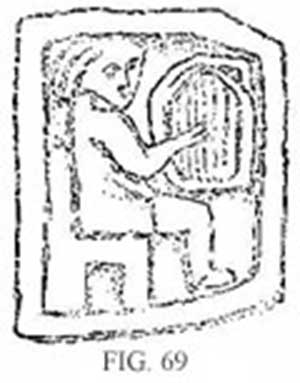Irish Harp and Timpan
From A Smaller Social History of Ancient Ireland 1906
« previous page | contents | start of chapter | next page »
CHAPTER XIII....continued
2. Musical Instruments.
The Harp is mentioned in the earliest Irish literature; it is constantly mixed up with our oldest legends and historical romances; and it was in use from the remotest pagan times. It was called crott or cruit, but cláirsech is now the name in general use. Several harps are sculptured on the high crosses, one of which is depicted on next page and another at p. 257, farther on, from which we can form a good idea of their shape and size in old times. From all these, and from several incidental expressions found in the literature, we can see that the harps of the ninth, tenth, and eleventh centuries were of medium size or rather small, the average height being about 30 inches: and some were not much more than half that height. Probably those of the early centuries were of much the same size—from 16 to 36 inches. The specimens of harps belonging to later ages—including "Brian Boru's harp" noticed below—are all small—still about thirty inches. But in more recent times it has been the fashion to make them larger.
FIG. 69. Harper on west face of High Cross of Castledermot, of about the end of tenth century. (From Miss Stokes's High Crosses of Castlertermot and Durrow).
The ordinary harp of the fifteenth and sixteenth centuries—as we know by many specimens remaining—had generally thirty strings, comprehending a little more than four octaves. Several harps of the old pattern are still preserved in museums in Dublin and elsewhere, the most interesting of which is the one now popularly known as Brian Boru's harp in Trinity College, Dublin. This is the oldest harp in Ireland—probably the oldest in existence. Yet it did not belong to Brian Boru; though it is likely as old as the thirteenth century. It is thirty-two inches high; it had thirty strings: and the ornamentation and general workmanship are very beautiful.
The Irish had a small stringed instrument called a Timpan, which had only a few strings—from three to eight. The body was a small flat drum or tympanum (whence the name) with a short neck added; the strings were stretched across the flat face and along the neck, and were tuned and regulated by pins or keys and a bridge, something like the modern guitar, or banjo, but with the neck much shorter. It was played with a bow, or with both a bow and plectrum, or with the finger-nail; and the strings were probably stopped with the fingers of the left hand, like those of a violin.
The harp—as well as the timpan—was furnished with brass strings. The tuning-key had a wooden handle tipped with steel, like the modern piano-key. Both harp and timpan, when not in use, were kept in a case, commonly of otter-skins.
In very early ages a professional harper was honoured beyond all other musicians. In the eighteenth century, almost everyone among the high and middle classes played the harp.

